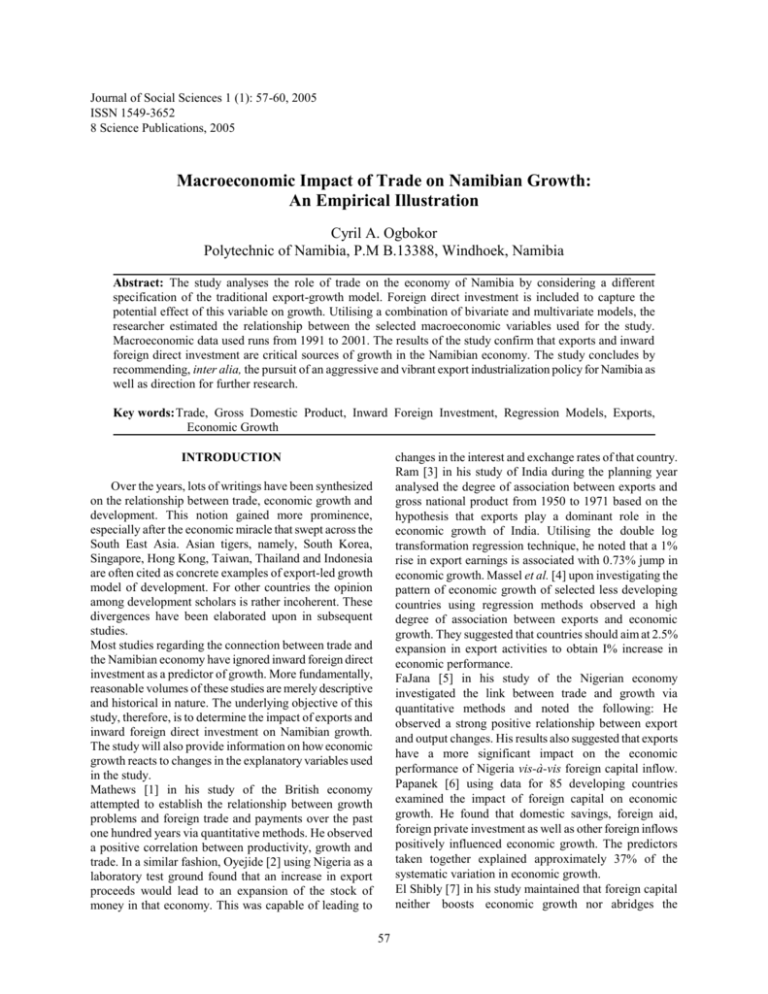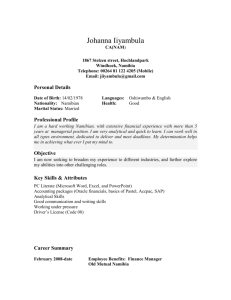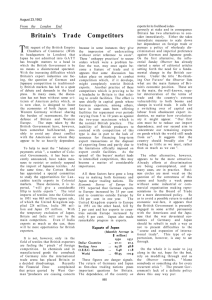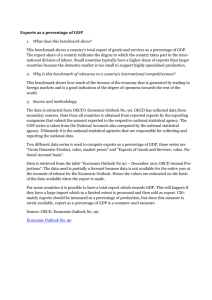Macroeconomic Impact of Trade on Namibian Growth:
advertisement

Journal of Social Sciences 1 (1): 57-60, 2005 ISSN 1549-3652 Science Publications, 2005 Macroeconomic Impact of Trade on Namibian Growth: An Empirical Illustration Cyril A. Ogbokor Polytechnic of Namibia, P.M B.13388, Windhoek, Namibia Abstract: The study analyses the role of trade on the economy of Namibia by considering a different specification of the traditional export-growth model. Foreign direct investment is included to capture the potential effect of this variable on growth. Utilising a combination of bivariate and multivariate models, the researcher estimated the relationship between the selected macroeconomic variables used for the study. Macroeconomic data used runs from 1991 to 2001. The results of the study confirm that exports and inward foreign direct investment are critical sources of growth in the Namibian economy. The study concludes by recommending, inter alia, the pursuit of an aggressive and vibrant export industrialization policy for Namibia as well as direction for further research. Key words: Trade, Gross Domestic Product, Inward Foreign Investment, Regression Models, Exports, Economic Growth changes in the interest and exchange rates of that country. Ram [3] in his study of India during the planning year analysed the degree of association between exports and gross national product from 1950 to 1971 based on the hypothesis that exports play a dominant role in the economic growth of India. Utilising the double log transformation regression technique, he noted that a 1% rise in export earnings is associated with 0.73% jump in economic growth. Massel et al. [4] upon investigating the pattern of economic growth of selected less developing countries using regression methods observed a high degree of association between exports and economic growth. They suggested that countries should aim at 2.5% expansion in export activities to obtain I% increase in economic performance. FaJana [5] in his study of the Nigerian economy investigated the link between trade and growth via quantitative methods and noted the following: He observed a strong positive relationship between export and output changes. His results also suggested that exports have a more significant impact on the economic performance of Nigeria vis-à-vis foreign capital inflow. Papanek [6] using data for 85 developing countries examined the impact of foreign capital on economic growth. He found that domestic savings, foreign aid, foreign private investment as well as other foreign inflows positively influenced economic growth. The predictors taken together explained approximately 37% of the systematic variation in economic growth. El Shibly [7] in his study maintained that foreign capital neither boosts economic growth nor abridges the INTRODUCTION Over the years, lots of writings have been synthesized on the relationship between trade, economic growth and development. This notion gained more prominence, especially after the economic miracle that swept across the South East Asia. Asian tigers, namely, South Korea, Singapore, Hong Kong, Taiwan, Thailand and Indonesia are often cited as concrete examples of export-led growth model of development. For other countries the opinion among development scholars is rather incoherent. These divergences have been elaborated upon in subsequent studies. Most studies regarding the connection between trade and the Namibian economy have ignored inward foreign direct investment as a predictor of growth. More fundamentally, reasonable volumes of these studies are merely descriptive and historical in nature. The underlying objective of this study, therefore, is to determine the impact of exports and inward foreign direct investment on Namibian growth. The study will also provide information on how economic growth reacts to changes in the explanatory variables used in the study. Mathews [1] in his study of the British economy attempted to establish the relationship between growth problems and foreign trade and payments over the past one hundred years via quantitative methods. He observed a positive correlation between productivity, growth and trade. In a similar fashion, Oyejide [2] using Nigeria as a laboratory test ground found that an increase in export proceeds would lead to an expansion of the stock of money in that economy. This was capable of leading to 57 J. Social Sci., 1(1):57-60, 2005 savings-investment gap. Using Sudan as a laboratory test ground, he found that most of the predictors used in the study positively impacted on economic growth except for the official and private foreign capital inflow variables. Sosa [8] investigated the connection between external debt and economic growth. By applying regression methods, he established a positive relationship between foreign capital and economic growth for the economy of Philippines. Aslam [9] relying on multiple regression analysis examined the effect of foreign capital inflows on domestic savings and investment in Pakistan. He noted the following: Net aggregate foreign capital negatively impacted on domestic savings but positively influenced investment. Similarly, public capital inflow was negatively related to domestic savings, while private capital inflow was found to have minimal effect on domestic savings. Also, project aid and bank credit variables highly influenced investment. Rana and Dowling [10] using a simultaneous equation model considered the impact of foreign capital on the economic growth of nine Asian countries. The study found that foreign direct investment, foreign aid, exports performance, changes in labour as well as domestic savings are good predictors of economic growth for the countries under investigation. Akerele [11] relying on appropriate quantitative techniques identified sources of instability in export earnings for the Nigerian economy for the period 1980-1997. He observed that political as well as economic factors provided sources of instability in Nigeria's export earnings. The influence of political factors is not surprising, since the period of the study coincided with the imposition of various sanctions on Nigeria for failing to adopt western-style democracy. Ogbokor [12] investigated the macroeconomic impact of oil exports on the economy of Nigeria. Utilising the popular OLS technique, he observed that economic growth reacted in a predictable fashion to changes in the regressors used in the study. He also found that a 10% increase in oil exports would lead to 5.2% jump in economic growth. He concluded that export-oriented strategies should be given a more practical support. However, empirical results obtained from other developing countries regarding the relationship between exports, foreign investment and economic growth are rather mixed. fluctuation in the economic performance of Namibia, simple as well as multiple regression models were relied upon. The software programme used in obtaining the regression estimates is known as Statistical Package for Social Sciences. The natural log transformation for each of the models were also specified and fitted. The use of the natural log transformation models allows the researcher to determine the responsiveness of economic growth to changes in the predictors used in the study. Secondary macroeconomic data utilised are highly aggregative in view of the core objective of the study. Data relied upon were obtained mainly from the various reports of the Central Bank of Namibia as well as the various statistical publications of the National Planning Commission of Namibia. Model Specification: The implicit general functional model relied upon for the purpose of this study is of the following nature: ARXt = f (CEXt, XEDt) Where: ARX = growth rate CEX = exports XED = t = foreign direct investment time factor A priori reasoning tells us that economic growth and exports move pari passu. Similarly, we expect a positive correlation between economic growth and foreign direct investment in view of a priori expectations. By differentiating the general model stated above with respect to each of the regressors, the following results are expected: d (ARX) --------- >0 d (CEX) d (ARX) -------- >0 d (XED) The specific equations derived from the general model for the purpose of estimation are, thus, presented as: ARXt = A0+A1CEXt+Ut ARXt = A0+A1XEDt+Ut ARXt = A0+A1CEXt+A2XEDt +Ut MATERIALS AND METHODS The respective natural log transformations of the above equations are: Data Sources and Procedure: The study uses time-series data covering 1991 to 2001. In order to isolate and analyse selected predictors, which have contributed to the LogARXt = A0+A1LogCEXt+Ut 58 J. Social Sci., 1(1):57-60, 2005 On inspection, the coefficients of the CEX as well as the XED terms were found to conform to a priori expectations in equation 3. The XED term in particular passes the significance test at both levels of 10 and 5%, while the CEX term was only significant at the 10% level. The high value of the adjusted coefficient of determination enables us to infer that exports and foreign investment inflows taken together are able to explain over 76% of the systematic variation in the regressand. One good thing about the model is the closeness of the D-W statistic to 2.0, the central value in the range of the statistic, indicative of the absence of serial correlation in the error terms. LogARXt = A0+A1LogXEDt+Ut LogARXt = A0+A1LogCEXt+A2LogXEDt+Ut RESULTS AND DISCUSSION It was observed that none of the estimated equations shows the presence of first-order serial correlation. In carrying out the Durbin-Watson test for autocorrelation, three regions were defined as against five regions. The idea behind using three regions was to suppress the two inconclusive regions. Literatures are available to support this process. Under each coefficient is the t-statistic in parenthesis. A two-tail test was used. The overall goodness-of-fit of the equations to the data is measured by the coefficient of determination (R2) and the adjusted coefficient of determination (R-2). The natural log transformations were generated for the purpose of elasticity analysis. The estimated results of the equations presented on page 58 are reported and discussed in the following sequence: An examination of eq. 1 shows the coefficient of the CEX term to conform to a priori expectation. The goodness-of-fit of the equation is fairly good. Exports alone are able to explain over 61% of the systematic variation in economic growth. The regressor CEX also passes the significance test at both the 5 and the 10% levels. The Durbin-Watson statistic of 0.836 suggests that the estimated equation is free of first-order serial correlation. ARXt=2931.116+1.399CEXt+3.400XEDt (.828) (3.786) R -2 =.765 (2.903) (3) D-W =1.708 The CEX coefficient is positive as expected and also significant at both levels of 10 and 5% in eq. 4. The value of the unadjusted coefficient of determination indicates that a good deal of the variance in the model is explained. More specifically, exports alone are able to account for over 64% of the systematic variation in economic growth. A 1% rise in CEX is expected to lead to 1.2% jump in ARX. The D-W statistic of 0.911 strongly indicates that the error terms in the model are not serially correlated. ARXt = -2347.343+2.560CEXt (-.572) (2.182) 2 R = .812 (1) LogARXt=-.654+1.164LogCEXt R2 = .614 R-2 = .572 D-W =.836 (-.259) (4.021) In equation 2, the coefficient of the XED term conforms to economic reasoning. The XED term passes the significance test at both levels of 10 and 5%. The goodness-of-fit of the equation is reasonably high in the light of the unadjusted coefficient of determination. The regressor i.e. foreign investment inflow is able to account for 70% of the systematic variation in economic growth. The positive coefficient of the XED term implies that foreign investment inflows and economic growth are expected to move in the same direction. Note that foreign investment inflow is made up of private as well as public investment inflows. The D-W value of 1.173 suggests that the equation is, at least, free of autocorrelation. (4) R2 = .642 R-2 = .603 D-W = .911 The sign of the XED term conforms to economic knowledge and also significant at both levels of 10 and 5% in equation 5. The goodness-of-fit of the model is reasonably high. Inward foreign investment alone is able to explain about 73% of the variance in ARX Thus, foreign investment appears to be an important variable in the growth process of Namibia. A 1% rise in XED will, ceteris paribus, generate 0.3% increase in ARX. The D-W value of 1.268 is an indication that the error terms are not auto correlated. LogARXt=8.217-.206LogXEDt (31.846) (4.895) ARXt=1 056T524+4.997XEDt (16.953) (4.587) (2) (5) R2 = .727 R-2= .697 D-W = 1.268 R2= .700 R-2= .667 D-W = 1. 173 The coefficients of CEX and XED terms conform to 59 J. Social Sci., 1(1):57-60, 2005 economic reasoning in equation 6. It is evident that the coefficient of XED passes the significance test at both levels of 10 and 5%, while that of CEX was only significant at the 10% level. The value of the adjusted coefficient of determination implies that exports and foreign investment taken together are able to account for about 78% of the systematic variation in ARX. A 1% rise in CEX will bring about 0.6% increase in ARX. Similarly, a 1% increase in XED will lead to 0.2% jump in economic performance. The D-W value of 1.593 suggests that the error terms are free of serial correlation. investigation in future research, the following points are highly recommended: The period covered by the time series data should be extended to cover, at least, fifteen years. More fundamentally, the effects of lagged explanatory variables should also be accommodated in the model. In conclusion, whether or not my professional colleagues agree with the premises on which the results of the study were obtained; they do in fact appear to provide some useful insights into the growth process, and indeed, we shall be satisfied if the evidence offered by the study can lead to more research on the issue under investigation. LogARXt= 3.371+.604LogCEXt+.138LogXEDt (1.428) (2.062) (2.837) (6) CONCLUSIONS ACKNOWLEDGEMENT I wholeheartedly wish to express my profound gratitude to my beloved wife Gladys A. Ogbokor and my three children Efemena, Elo and Eloho for their perseverance, sacrifice and moral support throughout the duration of the research. I am also indebted to Camillus Mahindi of the Department of Statistics, University of Namibia for accepting unconditionally to run the regression equations used in the study. This study identified and analysed some critical factors contributing to the fluctuation in Namibian growth by considering a different specification of the traditional export-growth model. The following suggestions and conclusions are put forward in the light of the findings of the study. Namibia needs to diversify and add value to its exports instead of focussing solely on the export of solid minerals and other primary products. In this regard, efforts should be directed at processing Namibia's primary products into semi-finished and finished industrial products before they are exported. This would enhance the competitiveness of these products in foreign markets. Namibia should explore the possibility of expanding the direction of her trade beyond the traditional ones of Germany and South Africa. Countries of Africa, Asia and Europe are potential markets for Namibian exports of solid mineral products, fish and beef products, and finished/semi-processed industrial products. The present policy of export-led industrialism through the establishment of export processing zones should be channelled towards promoting and sustaining growth in the export receipts of Namibia. Namibia should continue in its drive towards putting in place incentives capable of encouraging foreign investment. In this regard, the investment climate should be made more conducive and competitive in order to attract foreign investments needed for growth. Tax incentives among others should also be considered in this regard. Namibia should only target those investments that are compatible with its developmental goals and aspirations. As a way of improving the robustness of this empirical REFERENCES 1. Mathews, F.O., 1973. Foreign Trade and British Economic Growth. Scottish J. Politi. Econ., 20: 195-208. 2. Oyejide, T.A., 1974. Exports and Economic Growth in African Counties. Economic Internationale, 2: 177-185. 3. Ram, M., 1976. Trade-An Engine of Economic Growth: The case of India during the planning period. The Indian J. Econ., 56: 401-413. 4. Massel, B.F., 1972. Foreign exchange and Economic Development: An empirical study of selected Latin American Countries. Review of Economics and Statistics, pp: 208-212. 5. Fajana, O., 1979. Trade and Growth: The Nigerian Experience. World Development, 7: 73-78. 6. Papanek, G.F., 1979. The effect of Aid and Other Resource Transfers on Savings and Growth in Less Developed Countries. The Econo. J., 46: 934-950. 7. El Shibly, M., 1984. Foreign Capital Inflow, Domestic Savings and Economic Growth: The Experience of Sudan, 1960/61-1974/75. J. Econ., Develop., 9: 17. 8. Sosa, C.M., 1986. External Finance in the Economic Development of the Philippines. The Central Bank Rev., 38: 28 9. Aslam, N., 1987. The Impact of Foreign Capital Inflows on Savings and Investment: The case of Pakistan. Pakistan Develop. Rev., 29: 787-789. 10. Rana, P., 1988. The Impact of Foreign Capital on Growth: Evidence from Asian Developing Countries. The Developing Econ., 26: 3 11. Akerele, A.O., 2001. Nigeria's Export Trade: Instability and Forecast. J. Development Alternatives and Area Studies, 20: 61-68. 12. Ogbokor, C. A., 2001. Oil and Economic Growth: An Econometric Analysis. J. Develop. Alternatives and R2 = .822 R-2 =.777 D-W=1.593 In general, it was observed that the two predictors used in the study, namely exports and inward foreign investment made appreciable impact on Namibian growth during the period under investigation. 60 J. Social Sci., 1(1):57-60, 2005 Area Studies, 20: 124-130. 61





